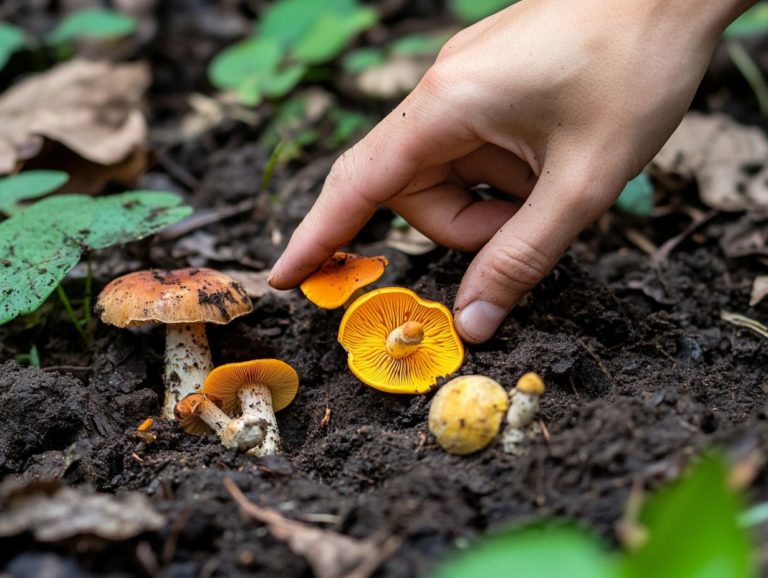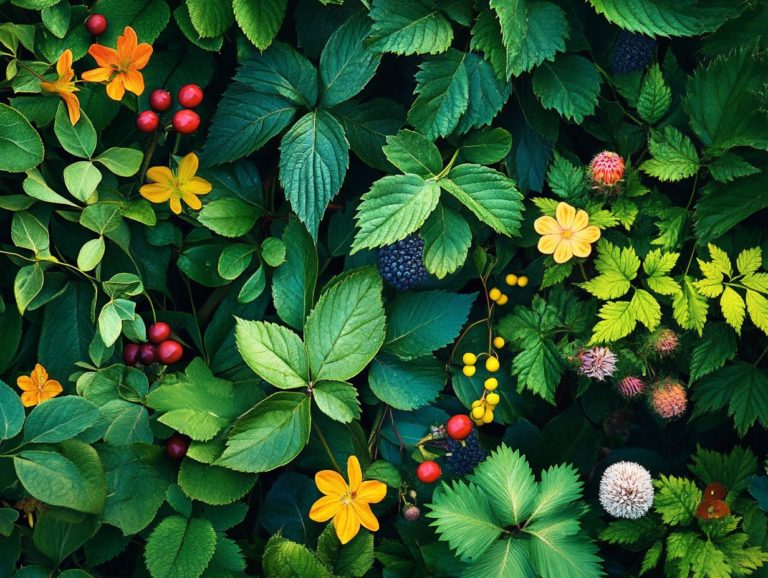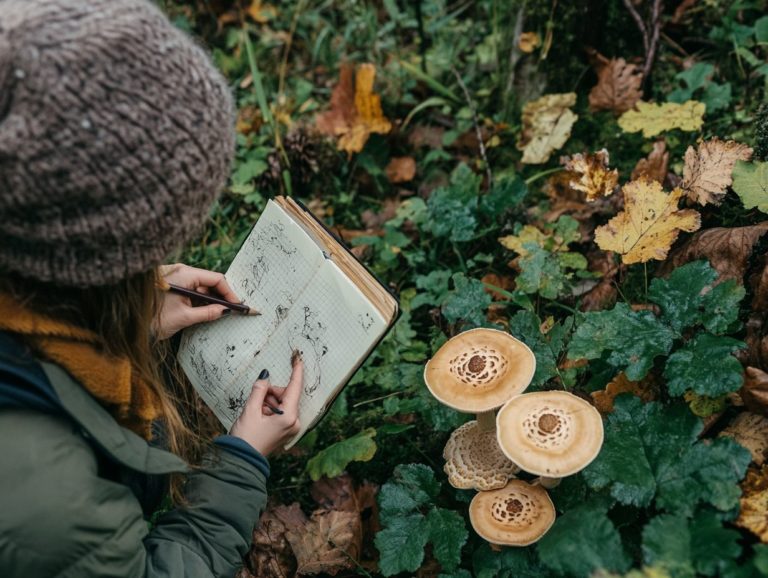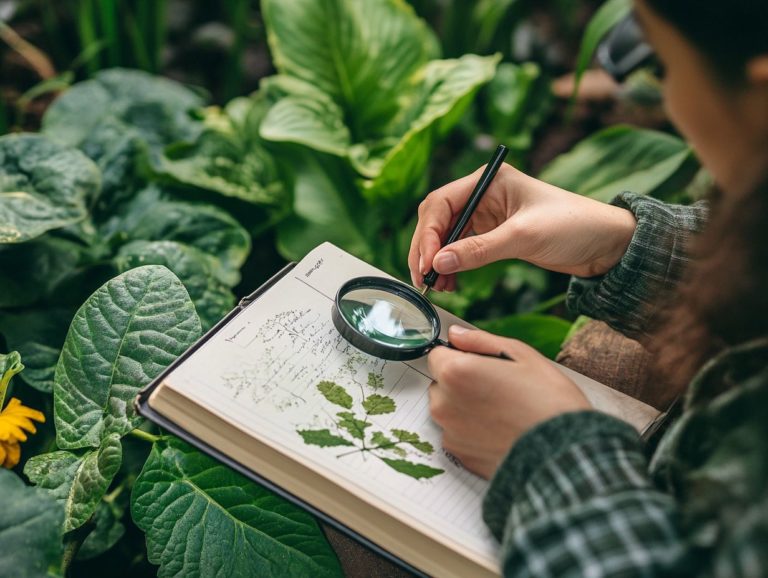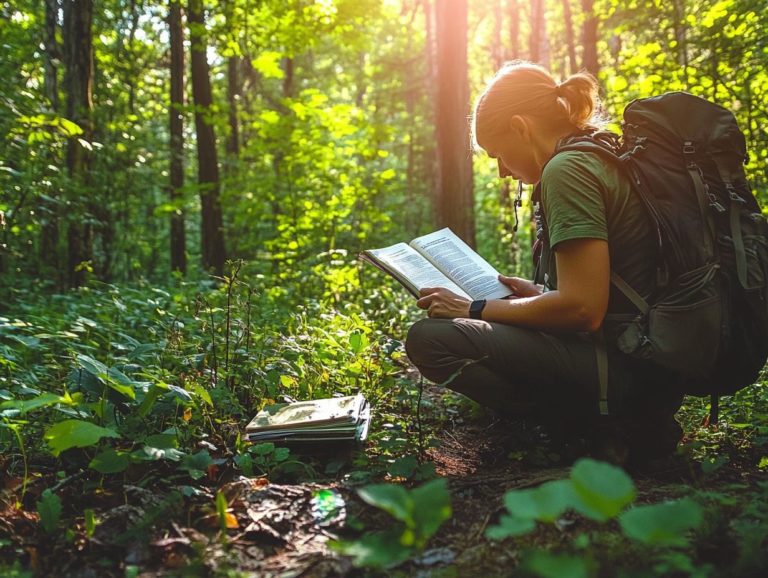A Beginner’s Guide to Edible Plant Identification
Discovering the world of edible plants opens up a rewarding journey into nature s pantry. Each hike or leisurely stroll can lead to delightful surprises waiting to be uncovered.
By mastering the art of identifying these plants, you enrich your culinary repertoire and cultivate a deeper connection with your environment.
This guide is your key to unlocking the wonders of nature! It will equip you with essential plant identification techniques, spotlight common edibles you may encounter nearby, and underscore vital safety precautions to steer clear of harmful lookalikes.
Embrace sustainable foraging practices that ensure your adventures benefit both you and the ecosystem. Dive in and unlock the secrets of the wild!
Contents
- Key Takeaways:
- Basic Plant Identification Techniques
- Common Edible Plants in Your Area
- Safety Considerations
- Tips for Sustainable Foraging
- Frequently Asked Questions
- What is edible plant identification?
- Why is it important to learn edible plant identification?
- What are some common edible plants?
- How can I start learning edible plant identification?
- What should I consider before eating a plant I have identified as edible?
- What are some safety precautions to keep in mind when foraging for edible plants?
Key Takeaways:
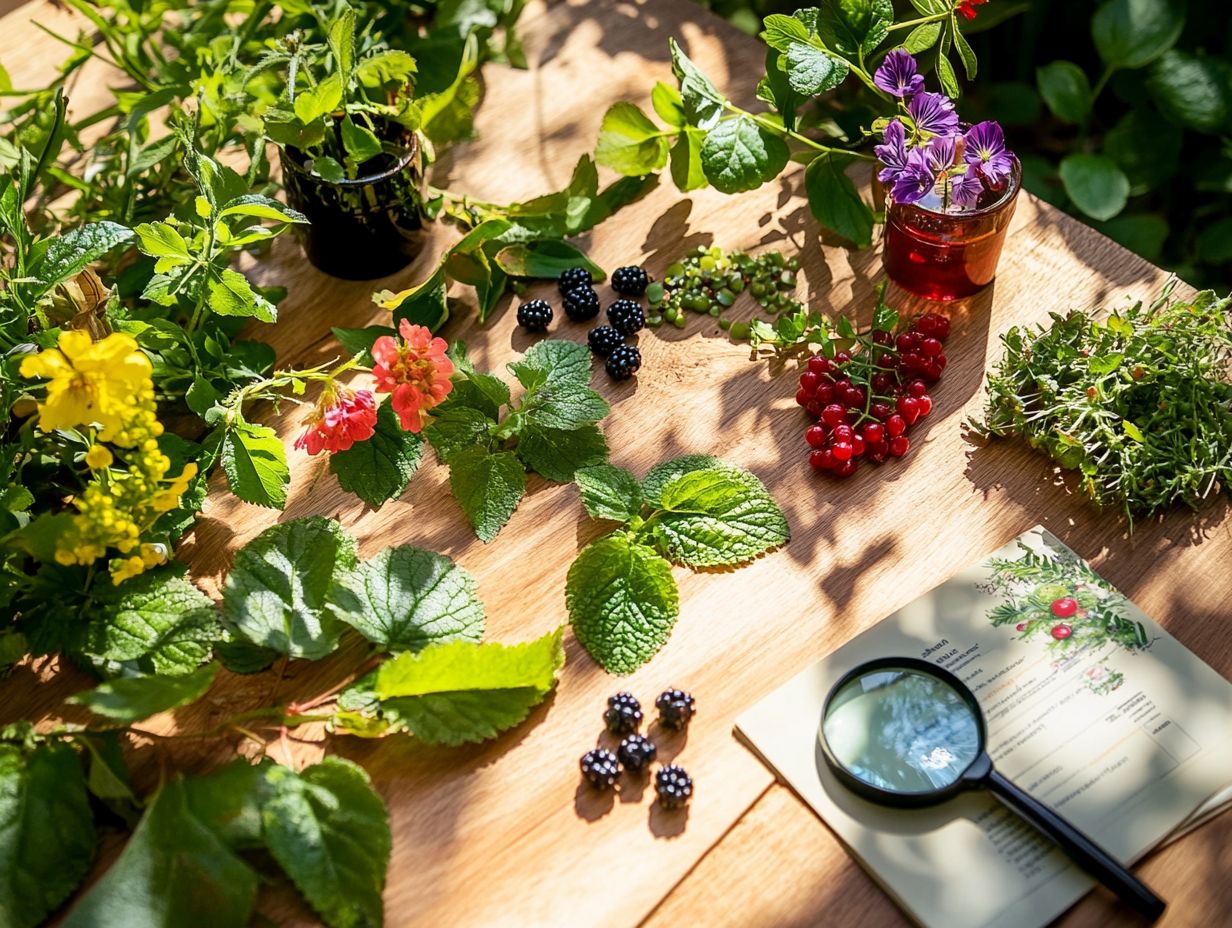
- Learning to identify edible plants is important for survival and sustainable living.
- Visual characteristics and plant parts are key factors in identifying edible plants.
- Identifying and harvesting wild edibles requires knowledge of common plants in your area, along with safety considerations for avoiding poisonous lookalikes and allergic reactions.
Why Learn to Identify Edible Plants?
Learning to identify common wild edibles is an invaluable skill. It empowers you as a first-time forager to truly appreciate and utilize the diverse offerings of the wild.
As you delve into the world of foraging, you embark on a transformative journey. This journey deepens your understanding of seasonal ecosystems and the variety of plants and animals around you.
The wild is brimming with a variety of nutrient-rich foods, from delicate greens and vibrant berries to hearty mushrooms and aromatic herbs. Each boasts unique flavors and health benefits.
With these rewards comes the vital responsibility of recognizing which plants are safe to consume. Keen observation and education are critical in this process.
By gaining insights into distinguishing edible plants from their toxic counterparts, you foster a sense of accomplishment and contribute to a sustainable lifestyle one that honors nature s offerings while prioritizing your well-being.
Basic Plant Identification Techniques
Mastering basic plant identification techniques is essential for confidently recognizing and harvesting wild edibles. Learning how to identify edible plants in the wild allows you to explore the outdoors with assurance and safety.
Familiarizing yourself with plant features, such as leaf shapes, flower arrangements, and growth habits, is vital to your success.
You can leverage plant ID apps like iNaturalist and Plantnet, alongside traditional field guides. This combination can significantly enhance your capacity to accurately identify plants in your area.
Visual Characteristics and Plant Parts
Recognizing visual characteristics and plant parts is essential for accurately identifying edible plants. For more in-depth knowledge, refer to wild edibles: a safe forager’s guide to identification, as these features provide invaluable clues about different species and their edibility.
- Leaf shape
- Flower color
- Stem structure
- Habitat
By mastering these traits, you can easily distinguish between common edible plants and their toxic counterparts, significantly enhancing your foraging skills.
Take elderberries, for instance. You can spot them by their compound leaves and clusters of small white flowers, which are followed by dark purple berries. On the flip side, toxic pokeweed may share a similar structure but reveals its danger through distinct features, like green berries that transition to a cautionary red or black when ripe.
Paying attention to the length, thickness, and color of stems can further assist in your identification efforts. Many edibles, like asparagus, showcase a sturdy green stalk, while harmful varieties might present a more fibrous or discolored appearance.
Cultivating a keen eye for these nuances enriches your foraging experiences and encourages safe exploration of the great outdoors.
Using Plant Identification Guides
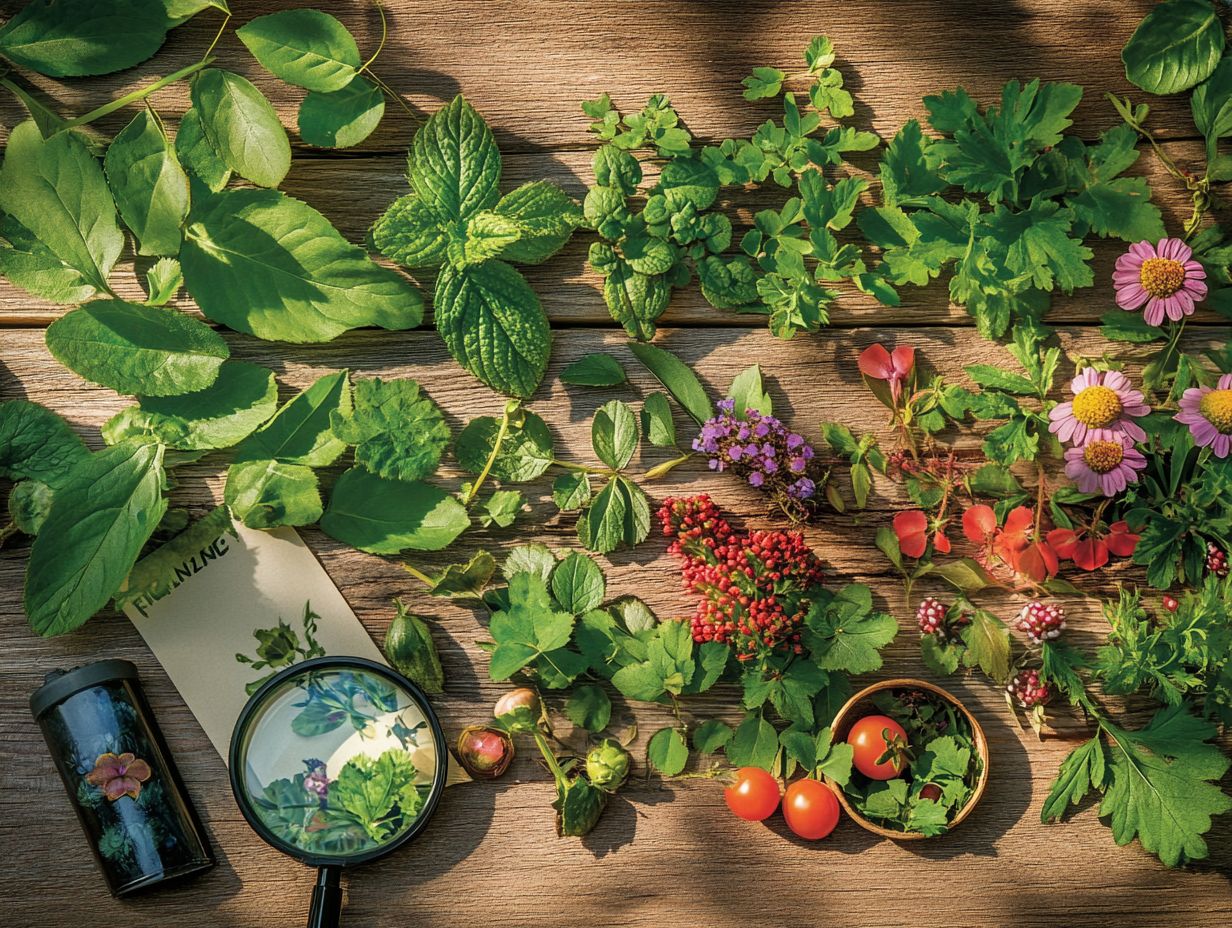
Using plant identification guides helps you recognize and understand wild edibles, offering reliable resources for identifying safe edibles and accurate information.
Choosing the right plant identification guide is essential. Traditional field guides offer precise illustrations and detailed descriptions that enable you to distinguish between similar species with confidence. On the other hand, digital resources like apps and online databases grant you the convenience of accessing information on the go, complete with community reviews to guide your choices.
Engage with local foraging groups to enrich your experience. Sharing knowledge and insights within these communities can ease your learning curve and foster valuable connections among fellow enthusiasts. Seek advice from local experts to deepen your understanding and ensure safe practices, allowing you to appreciate nature’s rich diversity while minimizing risks in your foraging adventures.
Common Edible Plants in Your Area
Familiarizing yourself with the common edible plants in your area is essential for successful foraging. With this knowledge, you are ready to embark on your foraging adventure by identifying and harvesting wild edibles in a responsible and sustainable manner.
Consider plants such as hickory nuts, blackberries, raspberries, cattails, and arrowheads these are just a few examples that can offer nutritious options.
By gaining hands-on experience in recognizing these plants, you ll cultivate a deeper understanding of your local ecosystem and its diverse edible offerings, ultimately enhancing both your skills and your confidence in foraging.
Identifying and Harvesting Wild Edibles
Identifying and harvesting wild edibles demands a harmonious blend of knowledge, practical experience, and a deep understanding of ethical foraging practices to ensure sustainability.
As you immerse yourself in the world of foraging, consider attending workshops or engaging with local foraging communities. This will enhance your grasp of which plants are safe to eat and how to differentiate them from potentially harmful look-alikes. The shared knowledge within these communities fosters a sense of friendship, prompting you to respect the land and its resources by adhering to sustainable techniques.
Embracing the principle of leave no trace encourages you to leave environments just as you found them, carefully observing regulations and local guidelines. These practices not only help preserve biodiversity but also cultivate a culture of stewardship, ensuring that future generations can savor the same wild culinary delights you enjoy today.
Safety Considerations
When foraging for wild edibles, safety considerations must always be your top priority. To avoid misidentifying plants, refer to guides on how to spot edible plants in the wild, as this can help prevent serious health implications, ranging from food allergies to poisoning from toxic look-alikes.
Familiarizing yourself with the universal edibility test becomes a crucial part of this journey, offering a systematic method to assess whether a plant is safe to eat. For first-time foragers, seeking expert guidance on identifying edible plants is invaluable, helping you navigate the inherent risks of foraging with confidence and care.
Poisonous Lookalikes and Allergic Reactions
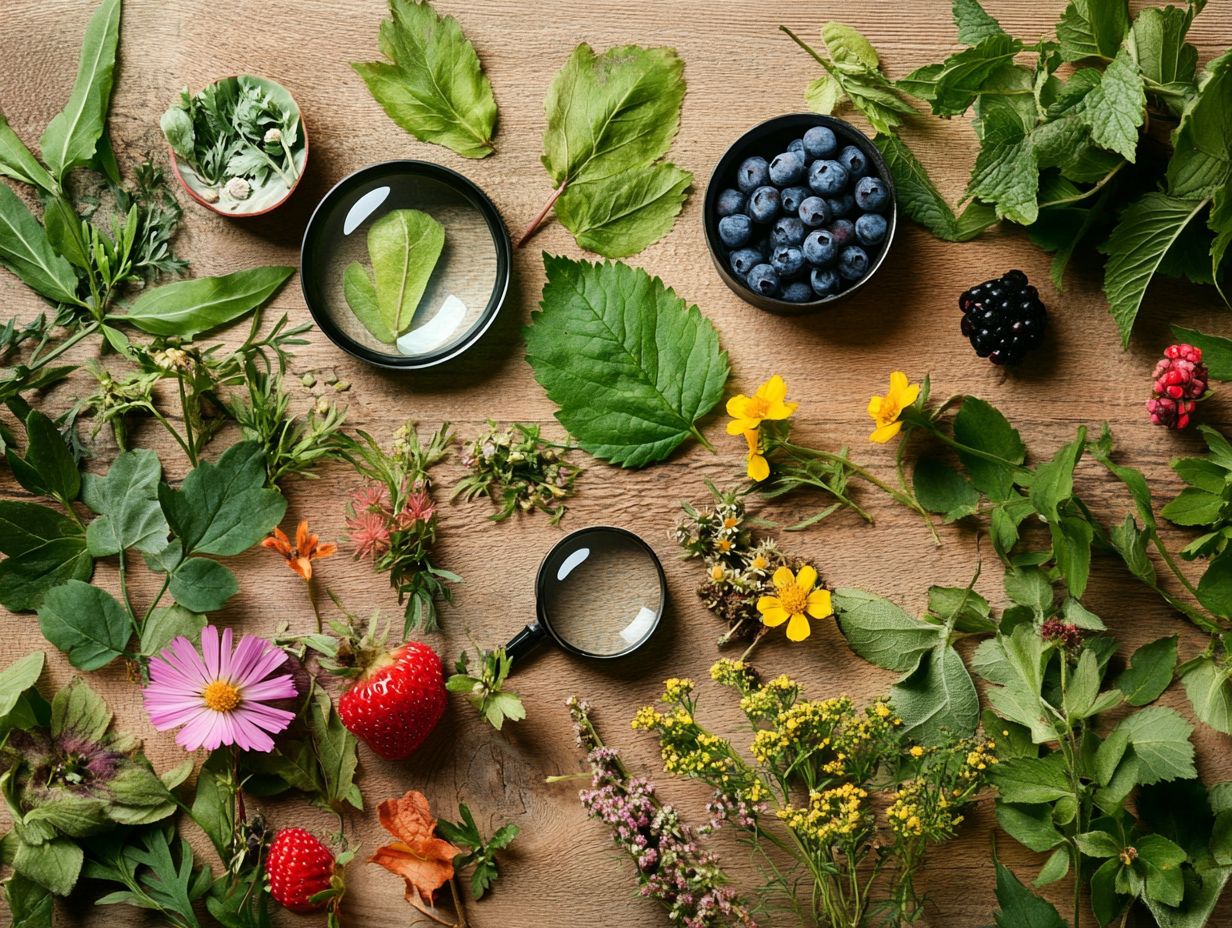
Understanding poisonous look-alikes is essential for anyone venturing into the world of foraging. Many edible plants have toxic counterparts that can pose serious health risks. Act now to avoid eating the wrong plants! Familiarize yourself with the identifying features of these dangerous look-alikes to prevent accidental ingestion and the potential for harmful allergic reactions. Educating yourself about common poisonous plants in your region is your best defense against foraging mistakes.
Take, for example, the striking resemblance between the edible wild carrot and its toxic cousin, poison hemlock. Both plants share similar leaf shapes. The wild carrot delights with a pleasant aroma, while poison hemlock gives off a foul smell similar to that of a mouse.
When foraging, you cannot underestimate the importance of being aware of food allergies. It s vital to ensure you re not introducing unfamiliar substances that could trigger bad reactions.
To mitigate these risks, carry field guides books that help you identify plants in the wild mark known edible plants, and consult experienced practitioners to deepen your understanding. These precautionary measures are key to promoting safe foraging practices, allowing you to enjoy the bounties of nature without the anxiety of unintended harm.
Tips for Sustainable Foraging
Sustainable foraging practices are crucial for preserving ecological balance and ensuring that wild edibles remain accessible for future generations. Practice responsible harvesting techniques, such as taking only what you truly need and adhering to conservation regulations. This plays a vital role in safeguarding local ecosystems.
Familiarize yourself with edible plant families and their growth cycles. This not only enhances your foraging experience but also contributes to sustainable practices that benefit both the environment and the community at large.
Responsible Harvesting and Conservation
Responsible harvesting and conservation are essential principles for anyone engaged in foraging. By ensuring that wild edibles can be enjoyed by future generations, you also play a role in preserving biodiversity. Practices like rotating your harvest locations not picking from the same spot every time to help plants grow back and respecting local regulations allow you to make a positive contribution to the ecosystems you engage with.
Participating in community crowdsourcing efforts can amplify these conservation endeavors, fostering a culture of shared responsibility among fellow foragers and nature enthusiasts.
To minimize your ecological impact, strive to leave at least one-third of each patch untouched. This simple act allows plants to regenerate, ensuring sustainability for the future. Getting involved in local conservation workshops can greatly enhance your understanding of native species and their habitats.
Successful initiatives, such as community-led seed swaps and foraging clubs, not only teach responsible practices but also promote collective stewardship of our natural resources.
By sharing your knowledge and experiences, you can harness the power of community to cultivate a supportive network dedicated to ethical foraging and the preservation of biodiversity.
Frequently Asked Questions
What is edible plant identification?
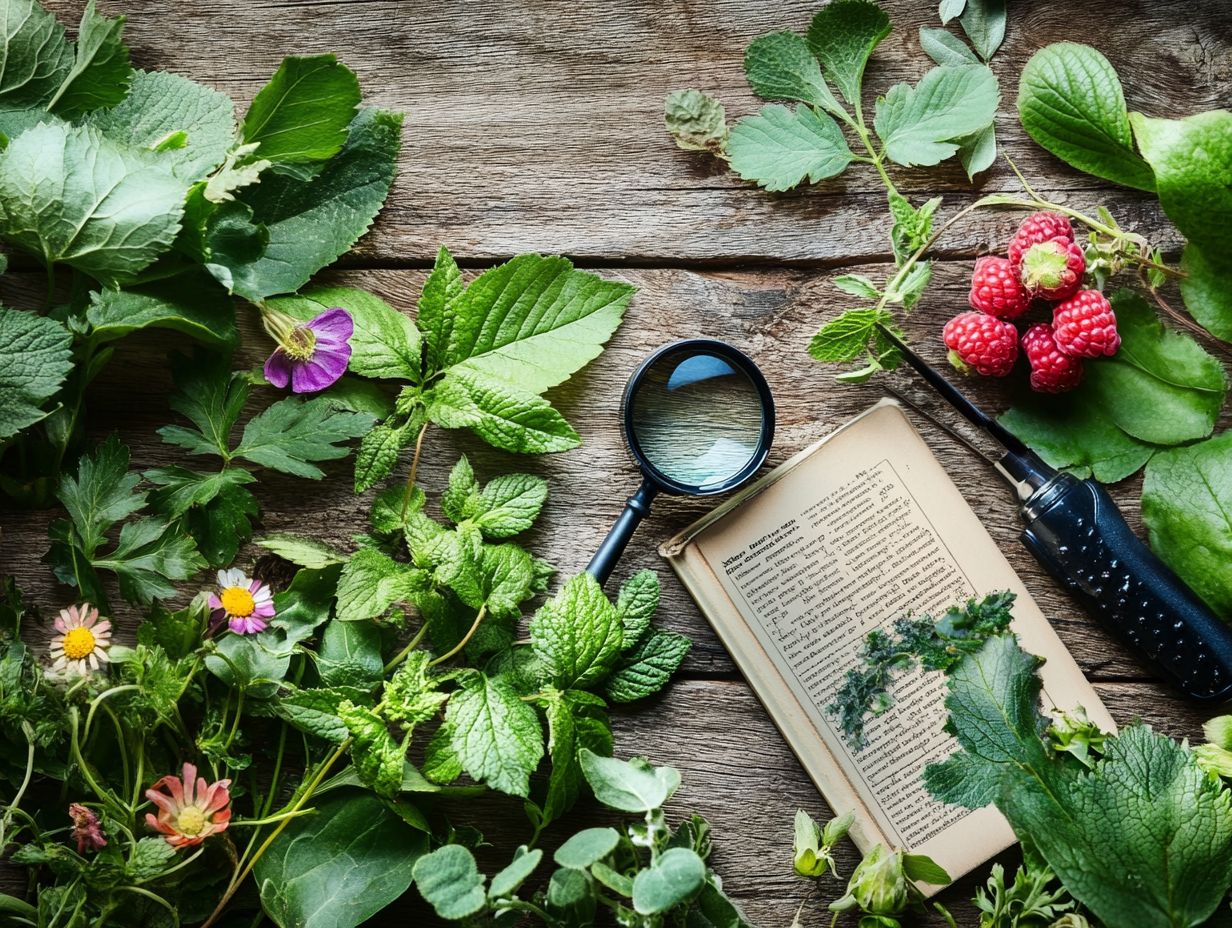
Edible plant identification is the process of learning to recognize and correctly identify plants that are safe and suitable to eat. This skill is crucial for those interested in foraging and harvesting their own food from nature, especially when using resources like identifying edible plants in spring.
Why is it important to learn edible plant identification?
Learning edible plant identification is crucial because it allows you to confidently and safely forage for food in nature. By understanding the basics of foraging: identifying edibles, you can avoid potential harm from consuming toxic or inedible plants.
What are some common edible plants?
Some common edible plants include berries, nuts, greens, and roots. Examples of specific edible plants include strawberries, blackberries, almonds, spinach, and carrots. It is important to properly identify these plants before consuming them.
How can I start learning edible plant identification?
Start your journey by taking a class or workshop. You can also study field guides and explore online resources.
Join an exciting guided foraging trip with an experienced forager for hands-on learning!
What should I consider before eating a plant I have identified as edible?
Double-check your plant identification using multiple sources. Ensure it s at the right growth stage and free from harmful pesticides.
If you have any doubts, do not eat it!
What are some safety precautions to keep in mind when foraging for edible plants?
Stay safe while foraging! Always wear appropriate clothing and stay alert to your surroundings.
Avoid areas with heavy pollution or chemical use. Only forage for plants you can confidently identify as safe to eat.

